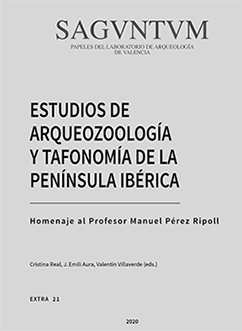El consumo de conejo (Oryctolagus cuniculus sp.) en el estrato IVB del Alto de las Picarazas
 Resumen
Resumen
The European rabbit (Oryctolagus cuniculus) is the most frequent species in the Pleistocene archaeological sites of Mediterranean area. For the few past decades explaining his presence in these contexts has been a challenge for zooarchaeological studies. Field of research where highlight the studies of Prof. Manuel Pérez Ripoll characterizing consistent taphonomic indicators that allow distinguish the agent responsible for the lagomorph bone accumulation in the Upper Palaeolithic subsistence strategies. Through their work discerns that rabbit hunting played a crucial role in the economy of late Palaeolithic hunter-gatherers from Mediterranean area. That contrast with the economic strategy documented to middle Palaeolithic, with a lagomorph’s hunting and consumption less significant.
This article presents a rabbit (Oryctolagus sp.) bones recovered from Alto de las Picarazas site of Lower Pleistocene chronology. Rabbit bones shows cut marks and human bites as consequence of processing and consumption. The article values the importance of lagomorphs capture and consumption by the first hominids.
 Descargas
Descargas
Descargas
Publicado
Cómo citar
-
Resumen343
-
PDF211
Número
Sección
Licencia

Este obra está bajo una licencia de Creative Commons Reconocimiento-NoComercial-SinObraDerivada 4.0 Internacional.
Con la publicación impresa de los trabajos, los/as autores/as aceptan que el Departament de Prehistòria, Arqueologia i Història Antiga de la Universitat de València pueda permitir la difusión y el libre acceso a través de las direcciones electrónicas y enlaces del editor/a.
El contenido de los trabajos es responsabilidad de los/as autores firmantes y no expresa la posición ni la opinión del Consejo de Redacción.
Las obras que se publican en esta revista están sujetas a los siguientes términos:
1. La revista conserva los derechos patrimoniales (copyright) de las obras publicadas, y favorece y permite la reutilización de las mismas bajo la licencia indicada en el punto 2.
2. Las obras se publican en la edición electrónica de la revista bajo una licencia Creative Commons Reconocimiento-NoComercial-SinObraDerivada 3.0 España (texto legal). Se pueden copiar, usar, difundir, transmitir y exponer públicamente, siempre que se cite la autoría, la url, y la revista, y no se usen para fines comerciales.
3. Los/as autores/as están de acuerdo con la licencia de uso utilizada por la revista, con las condiciones de auto-archivo y con la política de acceso abierto.
4. En caso de reutilización de las obras publicadas debe mencionarse la existencia y especificaciones de la licencia de uso además de mencionar la autoría y fuente original de su publicación.



